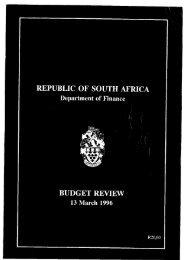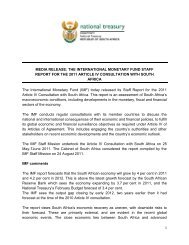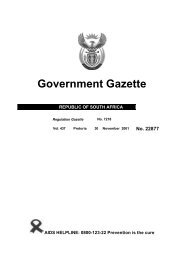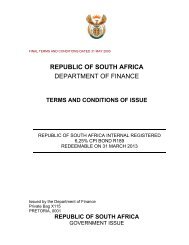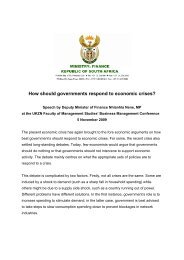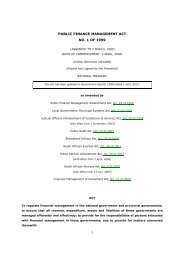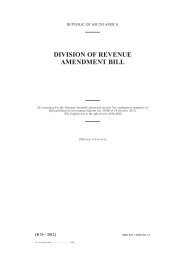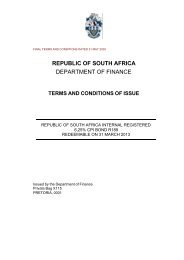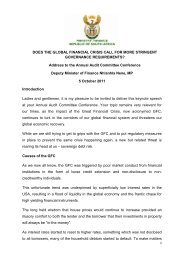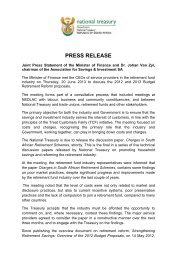1998 SOUTHERN AFRICA ECONOMIC ... - National Treasury
1998 SOUTHERN AFRICA ECONOMIC ... - National Treasury
1998 SOUTHERN AFRICA ECONOMIC ... - National Treasury
Create successful ePaper yourself
Turn your PDF publications into a flip-book with our unique Google optimized e-Paper software.
L E S O T H O<br />
The money market is developing steadily and there are now<br />
m o n t h ly auctions of tre a s u ry bills. In 1997 the central bank<br />
i n t roduced a Central Bank paper which is aimed at<br />
complementing the tre a s u ry bills. T h e re is no capital market in<br />
Lesotho as ye t , but in order to facilitate public sale of state<br />
enterprises the government has tasked the Privatisation Unit of<br />
the Ministry of Finance to coordinate the establishment of a<br />
stock exchange. Regulations governing the operations of the<br />
m a r ket are being pro mulgated under the Central Bank A c t .<br />
E x c h a n ge Contro l s<br />
P rofits and dividends from investments held in Lesotho may be<br />
repatriated fre e ly. All inward transfers of capital should be<br />
re g i s t e red with the central bank to facilitate subsequent<br />
re p a t r i a t i o n . Prior ap p roval is re q u i red for outward transfer of<br />
c ap i t a l .<br />
Residents are only allowed to transfer capital within the CMA<br />
re g i o n , and they are re q u i red by law to declare any fo re i g n<br />
exchange earnings within seven day s . Companies are howeve r<br />
a l l owed to invest outside the CMA, p rovided fo reign exchange<br />
earnings are re p a t r i a t e d .<br />
Fo reign Tr a d e<br />
M e rchandise exports have increased rap i d ly since 1986, g row i n g<br />
by a phenomenal 39.9 percent during 1996. M a nu f a c t u re d<br />
goods (pre d o m i n a n t ly from the textile and leather we a r<br />
industries) made up 76.3 percent of the total export value in<br />
1997 . Total exports to Africa (mainly SACU) have re g i s t e red 89<br />
p e rcent growth in 1996, and account for 71 percent of ove r a l l<br />
e x p o rt s . While the SACU countries remain the largest trading<br />
p a rt n e r s ,Lesotho is diversifying its markets to increase export s<br />
to North America in part i c u l a r, thus reducing its reliance on<br />
S AC U. L e s o t h o ’s network of trade pre fe rences has played a<br />
crucial role in providing favourable access to markets such as<br />
t h e s e.<br />
Main export products are clothing, f u r n i t u re, fo o t wear and<br />
wo o l . Lesotho imports corn, c l o t h i n g , building materials,<br />
ve h i c l e s ,m a c h i n e ry and medicines.<br />
Trade Liberalisation<br />
I m p o rt licenses are issued to licensed traders and<br />
m a nu f a c t u rers resident in Lesotho, and will only be issued fo r<br />
quantities not in excess of local demand.<br />
Fo reign Direct Inve s t m e n t<br />
L e s o t h o, in concert with other countries wo r l d - w i d e,<br />
recognises that FDI is important for the much needed<br />
e m p l oyment generation, i nvestment cap i t a l , and technology<br />
t r a n s fe r, and a lot of effo rt is being made to put in place a liberal<br />
FDI framework to facilitate greater direct inward inve s t m e n t<br />
f l ows into the country.<br />
FDI into Lesotho has increased steadily throughout the 1990s,<br />
f rom USD3m in 1992 to USD19m in 1994 and to USD28m in<br />
1 9 9 6 .<br />
The transformation of South Africa to a democracy has had a<br />
p o s i t i ve impact on the inflow of FDI to Lesotho. South A f r i c a<br />
remains the main source of FDI, accounting for nearly 38<br />
p e rcent of the total port fo l i o, p re d o m i n a n t ly in agri-business,<br />
construction and engineering, m a nufacturing and serv i c e s ,<br />
fo l l owed by East Asia (27 percent) which re g i o n ’s presence is<br />
l a r g e ly concentrated in the clothing, textiles and fo o t wear subs<br />
e c t o r. The residual 35 percent comes from Europe (e. g .<br />
G e r m a ny, S w i t z e r l a n d ,United Kingdom Po rtugal and Italy) and<br />
is mainly in the garment manufacturing business. Of the 23<br />
clothing manu f a c t u rers curre n t ly operating in Lesotho, 14 are<br />
f rom Taiwan and five are from South A f r i c a .<br />
All major infrastructure investments have been financed thro u g h<br />
external sources in the form of grants and concessional finance.<br />
The best known project is the LHWP that commenced in 1987.<br />
The project is immense in comparison with the economy of<br />
L e s o t h o, accounting for more than 25 percent of GDP in its<br />
peak construction year of 1994. The Katse dam enables Lesotho<br />
to supply water to the Gauteng area of South A f r i c a ,and it will<br />
also generate hy d roelectric power for the country itself. O t h e r<br />
infrastructural components of the project includes ro a d s ,<br />
b r i d g e s , p ower lines and power supply systems. T h e<br />
USD1,500m first phase of the project was completed at the<br />
beginning of <strong>1998</strong>, marking the start of the transfer of water<br />
t h rough a complex system of dams and tunnels from Lesotho to<br />
G a u t e n g .<br />
Lesotho Privatisation Prog r a m m e<br />
The legislation governing the privatisation programme was put<br />
in place in 1995. The programme is carried out by the<br />
Privatisation Unit of the Ministry of Finance, headed by a<br />
D i rector who is responsible to the Minister of Finance and<br />
Economic Planning.<br />
The participation of Basotho nationals in the privatisation<br />
p rogramme is deemed paramount for the success and<br />
acceptability of the pro g r a m m e. The government has thus take n<br />
a conscious decision to sell its smaller enterprises to the local<br />
business commu n i t y, and to re s e rve share holdings in larger<br />
enterprises for sale to employees and for future public<br />
f l o a t a t i o n . To facilitate such floatation the Privatisation Unit is<br />
charged with the task of coordinating work tow a rds the<br />
establishment of a capital market facility. F u rt h e r m o re the<br />
p rogramme encourages joint ve n t u res between fo re i g n<br />
i nvestors and individuals and groups in Lesotho’s business<br />
c o m mu n i t y. Cooperation is also encouraged between inve s t o r s<br />
in agro-industries and Basotho farmers who traditionally hold<br />
l a n d , but have had little incentive to grow cash-crops like<br />
a s p a r a g u s , fruits and flowe r s , which have proved to grow<br />
s u c c e s s f u l ly in Lesotho.<br />
The port folio of companies to be privatised includes more than<br />
t h i rty state-owned enterprises, and others in which the<br />
government holds shares through LNDC and the Lesotho<br />
D evelopment Bank. These include shares in South Africa based<br />
retail store s , a g ro - i n d u s t ry and utility companies (electricity,<br />
water and telecommu n i c a t i o n s ) .For the latter the gove r n m e n t<br />
is seeking to enter into strategic part n e r s h i p s . The national<br />
b a n k s , Lesotho <strong>National</strong> Development Bank and the Lesotho<br />
Agricultural Bank have been placed under a management<br />
contract to pre p a re them for privatisation.<br />
Privatisations to date include that of the national airline,L e s o t h o<br />
A i r w ays Corporation,which was sold to a South African chart e r<br />
c o m p a ny, Ross Air in August 1997 at about USD2.2m. This deal<br />
b rought about an application from the South African airline<br />
Airlink to have its traffic rights on the Johannesburg-Maseru line<br />
re i n s t a t e d ,resulting in creation of jobs and a healthy increase in<br />
the competition on the ro u t e.<br />
Other industries that are curre n t ly being privatised include the<br />
Lesotho Flour Mills, the Basotho Fruit and Vegetable Cannery,<br />
the International Freight and Tr avel Serv i c e,t wo mountain lodges<br />
and government mechanical wo r k s h o p s .<br />
I N V E S T M E N T C L I M AT E<br />
I nvestment Incentive s<br />
– A non-re p ayable skills training grant which covers up to 50<br />
35



